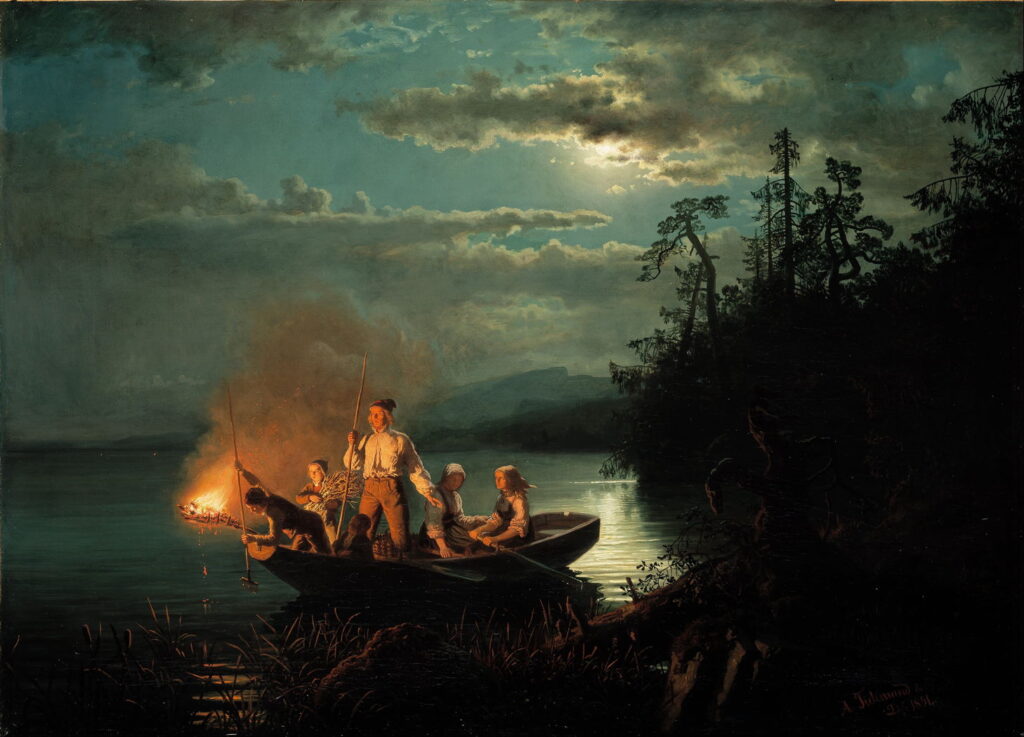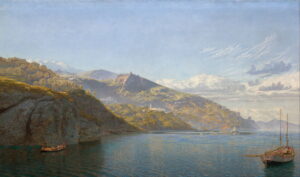Sea of Mists: Influenced, Hans Fredrik Gude

The last of these artists who were influenced by the German Romantic painters, notably Caspar David Friedrich and J C Dahl, is the Norwegian Hans Gude (1825–1903).
Born and initially educated in Christiania (now Oslo, Norway), Gude started his studies at the Academy of Art in Düsseldorf, Germany, in 1842. There he joined a recently formed landscape class taught by Johann Wilhelm Schirmer. Gude rejected the conventional teaching that landscape paintings should be composed according to classical or aesthetic principles, preferring instead to paint thoroughly realistically, and true to nature. On completion of his studies, probably in about 1846, he returned to Norway.
Hans Gude (1825–1903), Landscape Study from Vågå (1846), oil on canvas mounted on fibreboard, 28.5 x 42.5 cm, Nasjonalgalleriet, Oslo. Wikimedia Commons.
Landscape Study from Vågå (1846) is an excellent example of one of his early oil studies, and was probably completed in front of the motif, in Norway’s mountainous Oppland county north of the Jotunheimen Mountains. Although its background is loose and vague, foreground detail is meticulous for a work that appears to have been painted en plein air.
Hans Gude (1825–1903), Vinterettermiddag (Winter Afternoon) (1847), oil on canvas, 50.5 × 36 cm, Private collection. Wikimedia Commons.
Winter Afternoon from 1847 is a studio painting that wouldn’t look out of place on a greetings card, and a stark contrast.
Hans Gude (1825–1903), Tessefossen i Vågå i middagsbelysning (Tessefossen in Vågå at midday) (1848), oil on canvas, 119 x 109 cm, Private collection. Wikimedia Commons.
Tessefossen in Vågå at Midday (1848) is a relatively large studio painting that seems more typical of an American landscape painter of the day.
Early in his career, Gude struggled to paint realistic figures, and in several works he enlisted the help of Adolph Tidemand to paint those in for him.
Adolph Tidemand (1814–1876) & Hans Gude (1825–1903), Brudeferden i Hardanger (Bridal journey in Hardanger) (1848), oil on canvas, 93 × 130 cm, Nasjonalgalleriet, Oslo. Wikimedia Commons.
Among the results of this collaboration are some of his most spectacular works, such as Bridal Journey in Hardanger from 1848. Gude’s highly detailed and realistic landscape is set in the far south-west of Norway, in the region to the east of Bergen, where one of the world’s largest and most spectacular fjords carves its way from glacier to the sea.
Adolph Tidemand (1814–1876) & Hans Gude (1825–1903), Brudeferden i Hardanger (Bridal journey in Hardanger) (detail) (1848), oil on canvas, 93 × 130 cm, Nasjonalgalleriet, Oslo. Wikimedia Commons.
Although not a particularly large canvas, it’s as meticulously detailed as might have been expected from a Pre-Raphaelite or German Romantic artist, although its colours aren’t as brash. Gude became particularly interested in reflections on water later in his career.
Hans Gude (1825–1903), By the Mill Pond (1850), oil on paper mounted on cardboard, 34 x 47 cm, Nasjonalgalleriet, Oslo. Wikimedia Commons.
By the Mill Pond (1850) seems to have been another plein air study, but is so detailed that it would be hard to class it as a sketch. When looked at more carefully, though, many of its apparently precise passages turn out to consist of highly gestural marks, as in the lichens on the boulders in the foreground, and the small waterfall at the back. It’s also interesting in containing a figure, who may be Betsy Anker, whom Gude married in the summer of that year.
Adolph Tidemand (1814–1876) & Hans Gude (1825–1903), Lystring på Krøderen (Fishing with a Harpoon) (1851), oil on canvas, 115 × 159 cm, Nasjonalgalleriet, Oslo. Wikimedia Commons.
This later collaboration with Tidemand, Fishing with a Harpoon (1851), is a wonderful nocturne showing night fishing in sheltered waters, another masterpiece of detailed realism and influenced by German Romanticism.
In 1854, Gude was appointed professor in succession to his former teacher Schirmer, which was remarkable recognition for the Norwegian who was not yet thirty years old. He tendered his resignation three years later, but didn’t leave Düsseldorf for a further five years.
Hans Gude (1825–1903), Norwegian Highlands (1857), oil on canvas, 79 x 106 cm, Nasjonalgalleriet, Oslo. Wikimedia Commons.
Although painted in the studio, his Norwegian Highlands from 1857 appears based on studies made in front of the motif, and retains traditional earth-based colours typical of Friedrich or Dahl.
During the 1850s his paintings had aroused some interest in the UK, so in 1862 Gude travelled to Wales to try to develop his British market.
Hans Gude (1825–1903), Efoy (?) Bridge, North Wales (1863), oil on canvas, 41.5 × 55.5 cm, Nasjonalgalleriet, Oslo. Wikimedia Commons.
This painting of what he called ‘Eføybroen’, which might be an ‘Efoy’ Bridge, in North Wales was completed in 1863 from studies made in the previous autumn.
Hans Gude (1825–1903), The Lledr Valley in Wales (1864), oil on canvas, 63 x 98 cm, Nationalmuseum, Stockholm. Wikimedia Commons.
He also painted some grander landscapes of The Lledr Valley in Wales (1864), where he stayed during this campaign.
Gude continued to work by painting studies en plein air, which he took back to the studio and worked up into finished paintings. In contrast, local British painters at the time tended to complete their finished works in front of the motif, and seldom painted landscapes in the studio. When his paintings were exhibited at the Royal Academy in 1863 and 1864, they achieved little recognition, and failed to sell.
At the end of 1863, Gude was offered the post of professor at the Baden School of Art in Karlsruhe, which he accepted, as there was still no academy of fine art in Norway. During his tenure there, many Norwegians were students, including Kitty Kielland, Eilif Peterssen, Christian Krohg, and Frits Thaulow.
Hans Gude (1825–1903), Fjord Landscape with People (1875), oil on canvas, 36 × 56 cm, Private collection. Wikimedia Commons.
While he was teaching in Karlsruhe, Gude continued to promote the practice of painting en plein air, and his figures steadily improved. Fjord Landscape with People (1875) shows a typical period scene, with figures, cattle, horses, sailing vessels, and another of his wide open views.
Hans Gude (1825–1903), Estuary at Brodick, Arran, Scotland (1877), pencil and watercolor, 33.5 x 57.9 cm, Nasjonalgalleriet, Oslo. Wikimedia Commons.
Gude also worked in watercolours, and during his later career visited Scotland on several occasions, where he painted this almost monochrome view of an Estuary at Brodick, Arran, Scotland in 1877.
Hans Gude (1825–1903), Landscape with Tarbert Castle, Scotland (1877), watercolour and graphite, 35.8 x 54.4 cm, Nasjonalgalleriet, Oslo, Norway. Wikimedia Commons.
Gude’s watercolour Landscape with Tarbert Castle, Scotland (1877) shows one of the most famous ruined castles on the west coast of Scotland, on the shore of East Loch Tarbert, at the north end of the Kintyre peninsula.
Hans Gude (1825–1903), Sandvik Fjord (1879), oil on canvas, 54.5 x 81.5 cm, Nationalmuseum, Stockholm. Wikimedia Commons.
Sandvik Fjord (1879) is a startlingly detailed depiction of a view from above Sandviken, now the northern suburbs of the Norwegian city of Bergen, looking to the west and the island of Askøy.
In 1880, Gude moved to teach at the Academy of Art in Berlin.
Hans Gude (1825–1903), Oban Bay (1889), oil on canvas, 81.5 × 124 cm, Nasjonalgalleriet, Oslo. Wikimedia Commons.
He painted Oban Bay in 1889 following another visit to Scotland, showing the small bay beside the town of Oban on the west coast of northern Scotland. This bay opens out to the Sound of Kerrera, and is now a busy ferry port serving the Western Isles; at this time it seems to have been but a small fishing port. The prominent building in the distance just to the left of the centre of the painting is Saint Columba’s Cathedral, the seat of the Roman Catholic Bishop for the Western Isles. The distant mountains are those of the Morvern Peninsula, on the opposite shore of Loch Linnhe.
Hans Gude (1825–1903), Kaien på Feste i nær Moss (The Jetty at Feste near Moss) (1898), oil on canvas, 63 × 100 cm, Private collection. Wikimedia Commons.
The Jetty at Feste near Moss (1898) shows another marine view in the far south-east of Norway, on the eastern side of the broad fjord that leads north to Oslo.
Gude retired to Berlin in 1901, and died there in 1903, one of the founding fathers of Norwegian and Nordic landscape painting.
Reference




